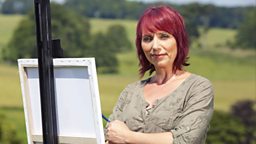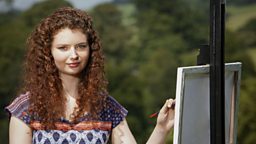Claire Parker
Modern Languages student Claire used to hide her artwork from everyone, including her parents, and kept her sketchbook like a secret diary. Her reluctance to share her work threatened to affect her art exams as she even struggled to reveal her work to her teachers. But recently gaining confidence, she finally decided to show her work and hopes to share her enthusiasm with others. Claire adores portraiture because she considers it the hardest art form, and enjoys the challenge of capturing more than a photographic likeness, saying: “If you put in a wrong line when painting an onion, for example, nobody minds, but with a person every line has to mean something”. Claire likes painting portraits of family and friends or still lives composed of mouldy fruit that she sets up in her room. But she is less keen on painting landscapes, and finds it hard to capture moving subjects. She is particularly inspired by Cezanne’s use of colour and the sensitivity and expressiveness of Rembrandt’s self-portraits, which she searches for in her own work. Currently studying French and Italian at the University of Cambridge, Claire is constantly striving to strike a balance between studying and finding time to paint.
Q&A
What first inspired you to get into painting?
I’m not really sure I “got into” painting – I think it has always been in me. I have always loved drawing from life, and distinctly remember being told off in art class at school for sketching the other students as they worked instead of developing my “Design Your Own European Hat” project. I have piles of sketchbooks full of doodles and quick sketches from life, but have never been very interested in working from photos. To “capture” something isn’t necessarily to reproduce it exactly – often I think it’s when fine details are lost that meaning and expression are gained.
What piece of your own artwork are you most proud of?
I feel most proud when I feel I’ve painted a portrait that captures more than a likeness. It’s a massive challenge, but good portraits say a lot about the subject, as well as the relationship between the subject and the painter. The first time I showed some of my work I was absolutely terrified, but when someone told me it had inspired them to paint and to take up creative writing again, it was a fantastic feeling. But I think it’s best not to dwell on the success of one particular painting; when Picasso was asked which of his paintings was his favourite, he replied “the next one”! I still have loads to learn, and I’m glad I’m not the finished article yet – that would be boring! Knowing that you can do better and have more to learn is what really spurs you on.
Have you had any artistic disasters?
No disasters, but for years I was terrified of showing anyone my work, even my family and my art teachers. When you put yourself into your work it’s hard to not feel exposed when you show someone else.
What was it like being critiqued by Lachlan and Daphne – what did you learn most from their weekly feedback?
Having two such well-renowned and successful artists critique my work was a great opportunity. But often I would give myself a harsher critique than the judges, and have learnt not to criticise myself too much because chances are there’ll always be someone else ready to do that for me! The judges said my work was sensitive and expressive, but that the lines I was making were not decisive or confident enough, and as I went on I began to find that confidence, whilst trying not to sacrifice my own style.
Which artist(s) has inspired you the most?
I’ve always loved Cezanne’s work. He gets an amazing balance between depth and surface, so that one mark might look like a brushstroke and a mountain in equal measure. And when it came to finding that balance he was a complete perfectionist; the colours are so pure, warm, and intense, that the paintings look like they’ve been done fairly quickly. But in reality they took Cezanne forever! - he even had to use wax fruit for his still lives because any real fruit would go off long before he could finish his work. I am also inspired by Rembrandt’s self-portraits (he painted almost 40 of them over his lifetime).I love how his expression changes as he gets older and frailer, becoming less confident and searching for answers. You can see the change in the brushwork as well, which becomes rougher and more unfinished. It’s basically a story of one man gradually coming to terms with his mortality, and it moves me every time. On the programme, I was really inspired by Amy’s strength and her ability to look at the world with fresh eyes, often finding really interesting ideas and forms in objects that others wouldn’t give a second glance.
What is your favourite thing to paint or draw?
I love portraiture, but the show has taught me to be a lot more open to other genres of painting and drawing. For example, I had only attempted plein air painting once before, sitting on the bank of the Cam and painting the river. A toddler came up to me with her mother, who said “Look at that painting, darling – isn’t it lovely?”. “Oh yes, mummy” replied the girl, “I wonder what it’s supposed to be…”. However, I now feel confident and inspired enough to set up my easel outside, and, spending the next few months in Italy, I’m hoping to find inspiration in the rich, warm colours of Italian towns and landscapes.
Quick questions…
Landscape or portraiture? Portraiture. The landscape of the face is the most beautiful one there is.
Acrylic or watercolour for painting? The programme got me into watercolour painting, but I still hate acrylics!
Pencil or ink for sketching? Both, but being left-handed, I like to use biro which doesn’t smudge.
Still life or life drawing? Got to be life-drawing, but I do think still life is a great genre and often overlooked.
Lachlan or Daphne? I think Lachlan probably had more belief in me throughout the show, but I absolutely love Daphne’s portraits and style of painting.












